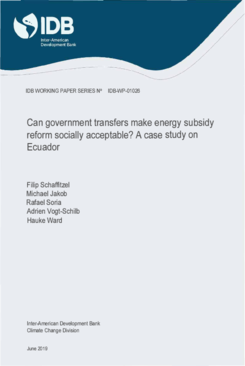Can Government Transfers Make Energy Subsidy Reform Socially Acceptable?: A Case Study on Ecuador
Date issued
Jun 2019
Subject
Energy Subsidy;
Liquefied Petroleum Gas
JEL code
O54 - Latin America • Caribbean;
Q54 - Climate • Natural Disasters and Their Management • Global Warming;
Q52 - Pollution Control Adoption and Costs • Distributional Effects • Employment Effects;
H23 - Externalities • Redistributive Effects • Environmental Taxes and Subsidies;
C67 - Input—Output Models
Country
Ecuador
Category
Working Papers
Energy subsidies account for about 7% of Ecuador’s yearly public spending, or two thirds of the fiscal deficit. Removing these subsidies would yield clear economic and environmental benefits and help implement climate targets set in the Paris Agreement. However, expected adverse effects on vulnerable households can make reforms politically difficult. To inform policy design, we use household survey data from Ecuador in combination with augmented input-output data to assess the distributional impacts of energy subsidy reform. We find that in absolute terms energy subsidies benefit richer households more than poor ones. Relative to household income, subsidy removal without compensation would be regressive for diesel and LPG, progressive for gasoline, and approximately neutral for electricity. We then analyze how a fraction of financial resources freed up by subsidy reform could be used to mitigate income losses for poor households by means of in-kind and in-cash revenue recycling schemes. Our results indicate that removing all energy subsidies and increasing the existing social protection program, Bono de Desarrollo Humano, by nearly US$ 50 per month would confer net benefits of almost 10% of their current income to the poorest quintile. In addition, more than 1.3 billion US$ would still be available for the public budget after the reform. Finally, we conduct expert interviews to evaluate the political and institutional challenges related to energy subsidy reform. We identify two combinations of reform options and recycling schemes that would benefit the poorest 40% of households and are deemed to be feasible: eliminating subsidies on gasoline while increasing the amount transferred to vulnerable households through the Bono de Desarrollo Humano and replacing universal LPG subsidies with targeted LPG vouchers.
Generative AI enabled




